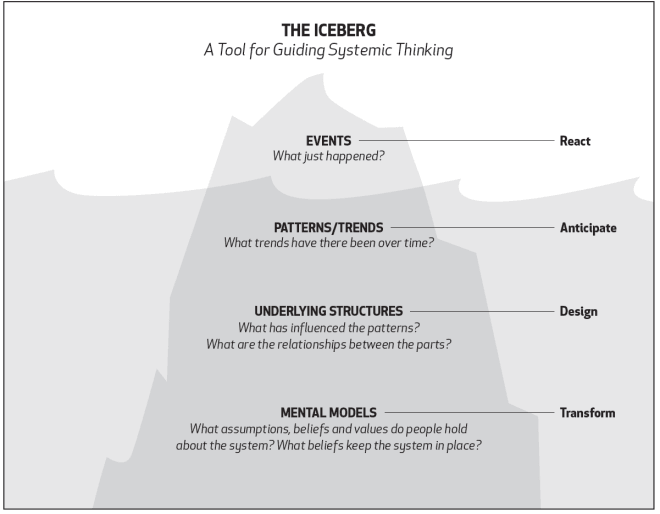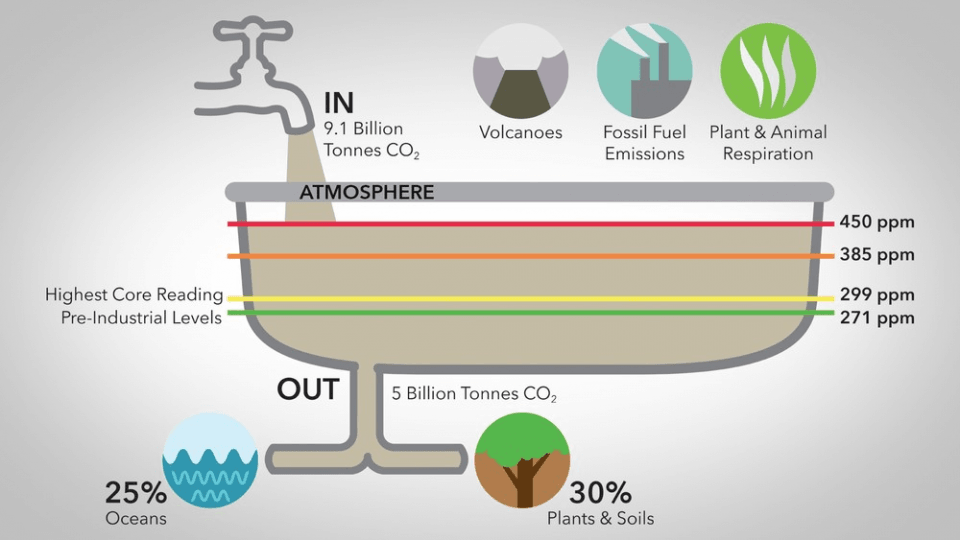Systems thinking in times of coronavirus: How companies and organizations can best prepare for the future
Sustainable Transformation COVID-19
The global coronavirus threat is a convincing new argument for the use of systems thinking, since the challenges we are facing have no borders and are all interlinked, often in invisible ways. This is exactly what systems thinking wants to do: to explore the relationships between different parts and the way they interact.
It makes perfect sense that all efforts are now focused on combating the virus outbreak. Nevertheless, we seem to have a hard time defeating COVID-19, because we can only see the tip of the iceberg. As is the case with real icebergs, the bulk is below sea level. In other words, a lot remains invisible to those who look at the phenomenon from a normal point of view.
The Iceberg: A tool for guiding systemic thinking
As Peter Senge describes in his book The Necessary Revolution: "We are so caught up in it that we get stuck and lose sight of the bigger picture." The tip of the iceberg indicates actual events that are tangible. They are attracting our attention–the number of coronavirus cases or deaths since yesterday. However, we fail to look at underlying patterns.

The iceberg model for guiding systemic thinking - Image credit: https://www.nwei.org/iceberg/
Below sea level
The bulk of the iceberg, which is below sea level, takes us a little deeper into the system. We could have better anticipated the events in China and Italy. Few countries did, because we failed to pay attention to the patterns of the underlying system structures.
"What are the forces underlying the coronavirus patterns and how do they arise?" "What proactive measures can abate the crisis?" "Why is it so difficult for people to slow down in time, before it is too late?"
These and other questions point to the recognition of the underlying system structures. The lower level challenges us to acknowledge the assumptions we hang on to. "We are all committed to preventing the spread of COVID-19, but how did it get this far?" "What in our thinking and acting allows the virus to keep spreading?"
The carbon dioxide bathtub analogy
The outbreak and spread of the coronavirus are a classic example of what happens when we do not tackle our challenges as parts of one system. And it is not the first time that a situation is exacerbated by not applying interdisciplinary measures based on systemic understanding.
Insufficient response to climate change is another well-known example. The now familiar 'flatten the curve' charts, which indicate how a peak can be prevented by spreading the number of infections over time, show many similarities with the carbon dioxide bathtub that became popular thanks to Donella Meadows’ book ‘Thinking in Systems: A Primer’.

 Source: image designed by raetastic for a Harvard energy course, 2015
Source: image designed by raetastic for a Harvard energy course, 2015
Why should companies and organizations look beneath the surface?
If people, companies, organizations, and governments only pay attention to the visible tip of the iceberg, they will only be able to react to changes when they occur. As a result, we will always be overtaken by events, as is the case now with the coronavirus crisis.
We are now seeing a 'lockdown' in several governments, companies, and organizations. In this way, we are all setting up a proactive strategy. At least, that's what we think. After all, acting proactively from a reactive point of view is just as reactive.
A better understanding of underlying structures and assumptions in the future can lead to positive transformation and lasting change.
Systems thinking at work
Companies and organizations who understand that their actions take place within a larger context can anticipate a crisis more quickly. Which in turn makes them also more resilient. Through new production lines and innovations, they can react quickly to help contain the coronavirus crisis.
For example, the French luxury conglomerate LVMH shut down the production of perfumes in order to make hand sanitizer instead, which they supply free of charge to health organizations. Both the Belgian company Xandres and lingerie manufacturer Van De Velde took action by producing face masks. There are also a number of organizations who are working together and building shared commitment. A fine example is the collaboration between Bio-Essential and AB InBev. Together, they are producing hand sanitizers and disinfectants from residual alcohol released during the production of alcohol-free beers.
The coronavirus provides an opportunity for companies and organizations to understand how to approach their business differently. This requires reconsidering their business model: instead of creating (economic) value, they should be able to evolve toward actively designing and creating products and services that deliver sustainable and inclusive growth.
The biggest challenge in Systems Thinking: to better recognize and understand our assumptions
Without understanding that global challenges such as the climate or the coronavirus crisis arise from the relationships between complex systems, today's crises will not be the last. The challenge remains to recognize the interconnected nature of human and natural systems. By applying systems thinking more, we can better recognize and understand our assumptions and thus become more resilient in current and future challenges.
The big question remains what we are all going to do, once the pandemic is over. Will governments boost the economy while forgetting about the climate crisis? Or will companies and organizations analyze the entire iceberg and use this momentum to make the transition to sustainable business models?
Jan Beyne, sustainability expert, PhD candidate and researcher at Antwerp Management School. Inspired by the book 'The Necessary Revolution' by Peter Senge.
Do you want to contact Jan Beyne? Or do you have a question? Let him know via Jan.Beyne@ams.ac.be.

comments0
You don't have the rights to read or add a comment.
Suggested Articles

